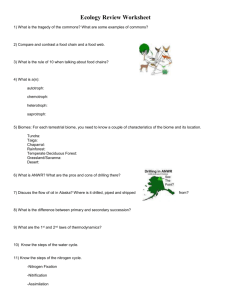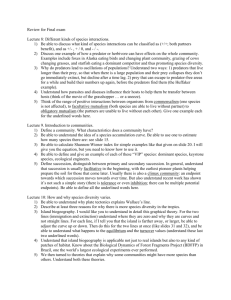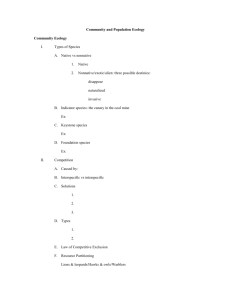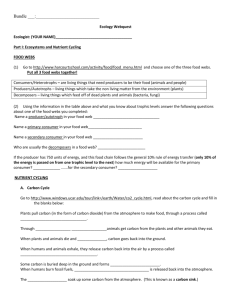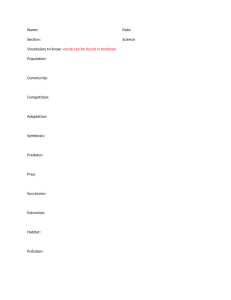ECOLOGY
advertisement
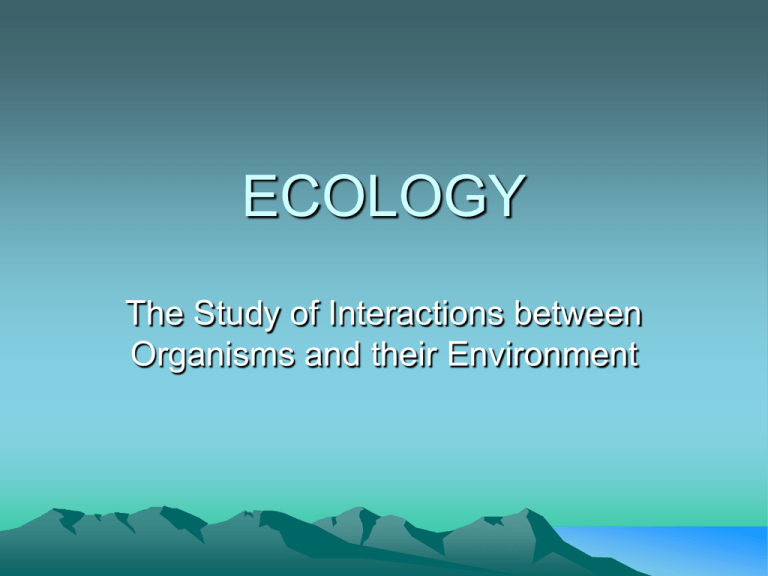
ECOLOGY The Study of Interactions between Organisms and their Environment Ecology Vocabulary • Population: a particular species in an area • Community: a group of populations in an area • Ecosystem: a community plus its non-living (abiotic) environment • Biosphere: all regions of the planet inhabited by populations • Habitat: The place a population lives • Niche: the role of the population in the environment (what you eat, what you do) ECOSYSTEM FACTORS • BIOTIC: Living (animals, plant, microbes) • AUTOTROPHS (produce food) plants • HETEROTROPHS-(need to get food) consumers- (eat ) Decomposers-(breakdown organics)Bacteria, fungi • A scavenger (vulture) is not a decomposer because they are not returning nutrients to the soil • ABIOTIC:Non-living temperature, sunlight, water, minerals Trophic Levels Trophic Levels • Primary Producers: The autotrophs that capture energy to make food (Plants) • Primary Consumers: heterotrophs that eat autotrophs (herbivores) • Secondary Consumers: heterotrophs that eat other heterotrophs (carnivores) • Higher Level Consumers: carnivores that eat other carnivores • Decomposers: consumers of dead organic material ( Bacteria, Fungi) ENERGY FLOW • Food chains: a specific energy pathway • Food webs: complex energy interactions found in an ecosystem. Energy pyramids: representation of the total energy available to a trophic level. FOREST FOOD WEB Arctic Marine Food Web Biomass Pyramid Energy Pyramid Kruger Park Battle Growth of Populations • Exponential Growth :occurs when individuals in a population reproduce at a constant rate. (in natural populations this does not occur for very long) • Carrying Capacity of the Environment:The maximum population that a particular environment can support • Limiting Factors : those environmental factors that keep a population at the carrying capacity, like food, predators, amount of water, how much land there is Population Growth over Time In 1944, 20 reindeer were brought to St. Matthew Island for an emergency food source.The Island is off the coast of Alaska in the Bering Sea. Initially there were abundant food sources, and the reindeer population increased dramatically. There were no predators to cull the population. However, about 20 years later, the reindeer had overshot the food carrying capacity of the island, and there was a sudden, massive die-off. About 99% of the reindeer died of starvation. Exponential growth can lead to massive die-off Carrying capacity of the Environment Community Interaction • competition • Competition- when populations require use of limited resources • Predator/prey- when one population depends upon another for food • Symbiosis- when two population’s Niche • Coincide with each other • Competition- Resource food or population may overlap Predator-Prey Interactions Predators : Organisms that catch and consume other organisms Prey : organisms that get consumed. Top Predator : the organism within a food chain or web that is not eaten by any other organism. Predation Predator – Prey Dynamics Symbiosis • When TWO or more species interact so closely that one or more of them is NECESSARY for the other’s survival. • Examples: Coral and zooxanthellae algae Fig trees and fig wasps(only way fig tree is pollinated. Fig enters fig and deposits eggs and pollen she brought along from another fig) Tape worms and humans (from undercooked meat, mostly pork.Live inside your intestines.Can grow 50ft long and live up to 20 years inside you) Fleas and hairy mammals Bed Bugs-Feed at night on unsuspecting Humans Mutualism • Both organisms BENEFIT from the interaction Red billed oxpecker feeds on the ticks Off the Impalas coat (Africa) Coral and Zooxanthellae Clownfish and Sea Anemone Crocodile and plover mutualistic relationship. Plover cleans crocodiles teeth. Commensalism – • one IS HELPED but the other is NOT harmed • Ex. Birds nest in trees Hermit crab with Sea Anemone living on it Parasitism One organism BENEFITS Malaria • The other is HARMED Predator Prey Co-evolution • Protection from Predation (for prey) – Poison : the production of toxins – Camouflage : protective coloration – Mimicry: look alikes • Adaptations to overcome protections (for predators) – Intolerance to poisons : immunity – Use of senses other than sight: hearing, smell Co-Evolution • Predator /prey interactions POISON IVY – protected from herbivores WARNING coloration says, “Don’t mess with me !!” Camouflage PROTECTIVE coloration caterpillar Stick insects found in Australia Mimicry • Similar colors • Similar DEFENSES Wasp/yellow jacket- no hair-keep stinging you Bee-hair on-some don’t sting others do. Mimicry- Fooled Ya! • King snake (not poisonous) If red touches yellow you’re a dead fellow If red touches black you’re a fine Jack Coral snake (VERY poisonous) Ecological Succession • The natural progression of SPECIES and their EFFECTS on the environment • PIONEER Species – the first to invade a new environment (bare rock) • MODIFICATIONS by the first group leads to the second, the second the third, etc. • The CLIMAX species will end the succession. • Primary succession-occurs on barren rock • Secondary succession occurs on an area that has been altered but not devoid of life Forest Succession Lake Succession 1. LAKE community 2. Sedimentation due to EROSION 3. SWAMP community forms 4. Eventually a FOREST community may form 5. Forest succession can occur Nutrient Recycling • • • • Carbon and Oxygen: CO2, O2 (AIR) Water: H2O (SOLID, LIQUID, GAS) Nitrogen: N2 (AIR) Other Minerals : MAGNESIUM, CALCIUM, IRON, ZINC, COPPER, SILICA, ETC. Carbon Cycle • Atmospheric CARBON DIOXIDE • Autotrophs- (Plants) change CO2 to O2 • Heterotrophs-(animals) use O2 release CO2 • Decomposers-(bacteria,fungus)- BREAK DOWN organic materials and release CO2 • Burning of FOSSIL FUELS- RELEASE CO2 Water Cycle • Evaporation- LIQUID TO WATER VAPOR • Transpiration- EVAPORATION THROUGH PLANTS stomates • Condensation and Precipitation- RAIN,SNOW, SLEET, HAIL etc. • Runoff and Groundwater INFILTRATION • Liquid water on the surface LAKES, STREAMS, OCEANS etc. NITROGEN CYCLE Free Nitrogen (N2) AMMONIA (NH ) Nitrogen Fixing Bacteria ANIMALS NITRATES (NO ) 3 Absorbed by Roots Decomposition 3 Eaten by Herbivores PLANTS Nitrogen cycle • Nitrogen in the Atmosphere -78% of Air • Nitrogen fixers- bacteria • Plants and animals-plants absorb nitrates and animals eat plants • Decomposers-bacteria that help with decay – Nitrifying Bacteria – Denitrifying Bacteria Other Minerals • • • • • • Rocks and Soil CONTAIN MINERALS Erosion RELEASES MINERALS Water dissolves MINERALS Plants and Algae uptake MINERALS Animals consume plants and animals Decomposers LEAVE MINERALS IN SOIL



